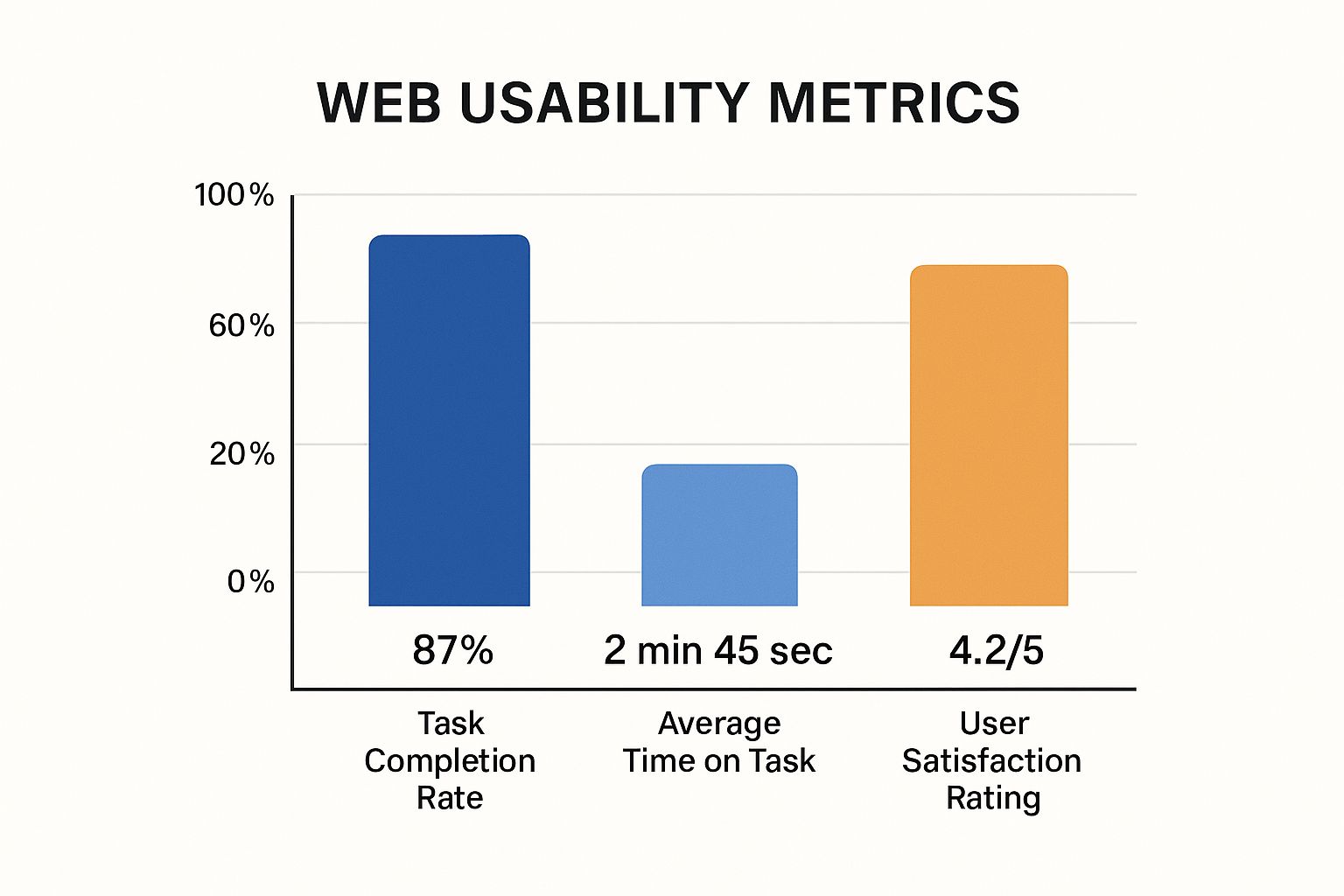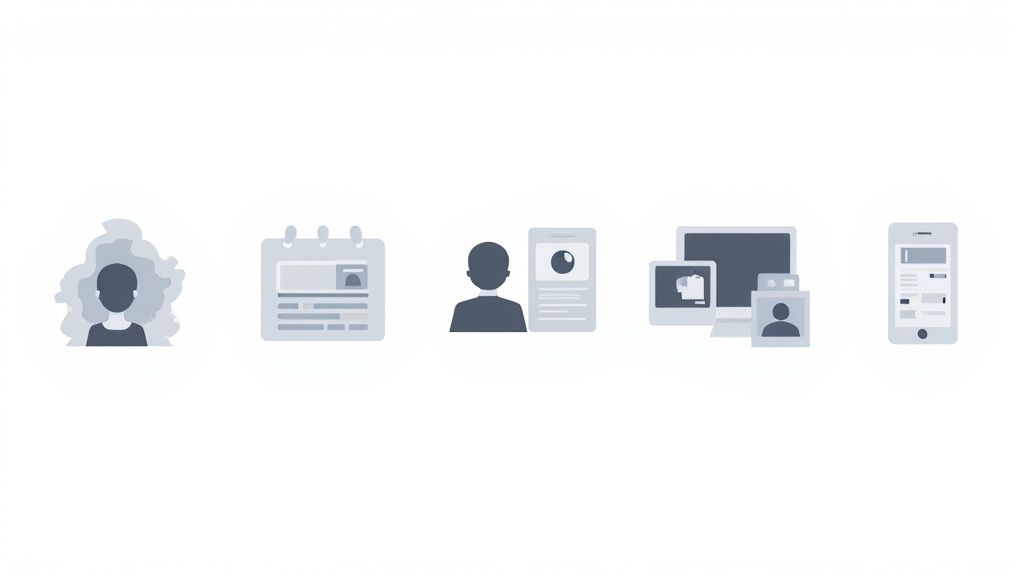Web Usability Test Tips to Improve Your Site
- shems sheikh
- May 31
- 11 min read
Understanding What Web Usability Test Really Means
A web usability test helps us understand how easily users navigate and interact with a website. It's not about how pretty the website looks, but how well it works. We observe real users as they try to do specific things on the site, like finding a product or contacting customer support. This helps us find hidden friction points – those little annoyances that frustrate users and hurt conversions.
Imagine someone trying to buy a product but getting stuck on a confusing checkout page. Internal teams might miss this, but a usability test would catch it. These tests go beyond simple feedback; they dig into the why behind user behavior. This provides valuable insights that can significantly improve your digital strategies. Just like the idea of shift left testing, integrating web usability testing early in development is key.
Key Metrics in Usability Testing
Usability tests measure several crucial metrics. The infographic below shows data from a sample test, focusing on Task Completion Rate, Average Time on Task, and User Satisfaction Rating.

A high Task Completion Rate (87%), a low Average Time on Task (2 min 45 sec), and a strong User Satisfaction Rating (4.2/5) suggest a positive user experience. These metrics clearly show how well a website meets user needs. Surprisingly, only about 55% of companies conduct any online usability testing as of early 2025. More detailed statistics can be found here.
Core Principles of Effective Testing
Effective usability tests rely on a few key principles:
Clear Objectives: Define specific goals to get focused results.
Representative Users: Choose participants who reflect your target audience.
Realistic Scenarios: Design tests that mirror how people actually use your website.
These principles ensure actionable results, not just general advice. This allows businesses to make data-driven decisions based on real user behavior. This leads to a better user experience and improved business outcomes.
To further explore different usability testing methods, let's examine this comparison table:
The following table, "Types of Web Usability Testing Methods," compares various approaches to usability testing, outlining ideal use cases and implementation needs.
Testing Method | Best For | Time Required | Cost Level | Participant Count |
|---|---|---|---|---|
Moderated Remote Testing | In-depth qualitative feedback, complex tasks | 1-2 weeks | Medium | 5-10 |
Unmoderated Remote Testing | Large-scale quantitative data, simple tasks | A few days | Low | 50+ |
Guerrilla Testing | Quick feedback on early prototypes | A few hours | Low | Small, opportunistic sample |
A/B Testing | Comparing design variations | Varies depending on traffic | Low to Medium | Implicit through website traffic |
Eye Tracking | Understanding visual attention and patterns | 1-2 weeks | High | Smaller, focused group |
This table provides a quick overview of how different methods address various needs and resources. Moderated testing offers rich insights, while unmoderated testing allows for broader data collection. Guerrilla testing offers rapid feedback, A/B testing focuses on design comparisons, and Eye tracking delves into visual behavior. Each method has its own strengths and weaknesses. Choosing the right approach depends on your specific goals, budget, and timeline.
The Real Business Impact of Web Usability Test Programs

Regular web usability testing does more than just improve the user experience. It delivers measurable business results that directly affect your bottom line. Companies that make user testing a priority often see significant improvements in their key performance indicators, translating into real financial gains.
Quantifiable Benefits of Usability Testing
Usability testing has a significant impact on business outcomes. It's not simply about making a website user-friendly; it's about boosting revenue. Companies investing in iterative web usability testing see impressive average revenue growth.
These gains can range from 10% to 15% compared to competitors who don't prioritize such testing. Learn more about this correlation here. These improvements also frequently lead to reduced development costs by catching and fixing problems early in the process.
From Expense to Investment: Shifting the Mindset
Many organizations mistakenly view usability testing as an optional expense. However, successful companies recognize its true nature: a strategic investment. They understand that even small usability improvements can compound over time, leading to substantial competitive advantages.
For example, a streamlined checkout process can result in higher conversion rates, which directly translates to increased sales.
Securing Buy-In for Usability Testing Programs
Getting stakeholder buy-in is crucial for establishing a robust testing program. This involves demonstrating the value of web usability testing through data and real-world examples.
By showcasing how usability improvements translate into increased profits, securing necessary resources becomes much easier. This investment facilitates sustained growth. A clear ROI calculation is often highly persuasive for decision-makers.
Measuring Long-Term Success With Usability Metrics
Looking beyond immediate financial benefits, long-term success is paramount. This involves tracking key performance indicators that relate to usability.
These indicators might include:
Reduced support tickets
Increased user engagement
This data provides continued support for usability testing initiatives and reinforces the value of a user-centered design approach. A solid web usability test program ultimately leads to a better user experience and a healthier bottom line.
Calculating ROI From Your Web Usability Test Investment
Understanding the return on investment (ROI) for web usability testing is essential. It not only justifies the resources allocated but also highlights the financial advantages of user-centered design. This section explores proven methods used by companies that recognize the value of these metrics. These frameworks measure both the immediate and long-term benefits of investing in usability testing.
Quantifying Cost Savings and Revenue Growth
A critical aspect of calculating ROI involves assessing cost savings. Web usability tests can identify problems early in the development process. This proactive approach prevents expensive post-launch fixes. Imagine a company launching a website with a broken checkout process. A usability test could have caught this, saving potential revenue loss and the cost of emergency repairs.
Usability testing can also quantify revenue increases from improved conversion rates. A more user-friendly website often translates to increased sales. This rise in conversions can be directly linked to the improvements made as a result of testing, demonstrating a clear connection between usability and profitability.
Measuring the Value of Reduced Development Cycles
Beyond immediate financial benefits, web usability testing contributes to shorter development cycles. By identifying design flaws early on, teams avoid wasted time and effort. This accelerates the entire development process, leading to a faster time-to-market for new features and products. This efficiency translates into cost savings and helps companies stay competitive. The ROI for usability testing is remarkably high. Studies suggest every dollar invested in UX, including usability testing, returns an average of $100 (an ROI of 9,900%). Find more detailed statistics here.
Tracking Key Performance Indicators
Tracking key performance indicators (KPIs) directly related to usability improvements is crucial. These KPIs could include:
Reduced support tickets: Fewer usability problems result in fewer calls and emails to customer support.
Increased user engagement metrics: Improved design fosters higher user satisfaction and more time spent on the website.
Improved task completion rates: A well-designed website enables users to achieve their goals more efficiently.
These metrics provide concrete evidence of the positive impact of web usability testing. This data supports continued investment in usability initiatives.
Building Compelling Business Cases for Ongoing Support
Using industry data and proven calculation methods builds compelling business cases. These cases help secure continued support for usability testing programs. Clearly demonstrating the financial benefits of usability testing simplifies the process of obtaining resources and gaining buy-in from stakeholders. This ensures the long-term success and effectiveness of your web usability testing efforts. Establishing clear success metrics is also vital for evaluating the impact of testing programs.
Planning and Running Web Usability Test Sessions That Work

Successful web usability testing hinges on meticulous planning and execution. This systematic approach ensures you gather actionable insights, covering every stage from defining research questions to selecting suitable participants. Careful consideration of each step, from planning to analysis, is key.
Defining Research Questions and Recruiting Participants
The cornerstone of any web usability test lies in defining clear research questions. These questions should adhere to the SMART criteria: Specific, Measurable, Achievable, Relevant, and Time-bound.
For example, instead of a broad question like "Is the website user-friendly?", a more focused question would be "Can users complete the checkout process within three minutes with fewer than three errors?". This specificity streamlines the testing process and yields actionable data.
Recruiting participants who represent your target audience is crucial. This ensures the feedback aligns with your actual users’ experiences. Think of it like casting for a play – finding the right individuals to accurately represent the roles. A diverse group provides a broader range of perspectives on your website's usability. For more in-depth information, you might find this resource helpful: How to master usability testing.
Creating Realistic Test Scenarios and Task Scripts
Realistic test scenarios are essential for gathering authentic user feedback. These scenarios should mirror real-world user goals on your website.
For an e-commerce site, a practical scenario could involve asking participants to find a specific product, add it to their cart, and complete the checkout process. This simulates a typical user journey.
Effective task scripts guide participants through these scenarios. These scripts should be clear, concise, and encourage natural behavior without leading the participant. This ensures interactions with the website mimic real-world usage. These scenarios and scripts form the backbone of successful usability testing.
Establishing the Testing Environment and Choosing the Right Approach
The testing environment significantly impacts the quality of your results. A controlled environment minimizes distractions and facilitates focused observation.
However, participant comfort is equally important to ensure natural behavior. Balancing these two aspects ensures accurate and representative feedback.
Two main approaches exist for web usability testing: moderated and unmoderated. Moderated testing involves a facilitator guiding participants in real-time, providing richer qualitative data. Unmoderated testing allows independent completion at the participant's own pace, offering greater scalability. The best approach depends on your specific research questions and available resources.
By adhering to these best practices, your web usability test will provide valuable data to improve your website. This ultimately leads to increased user satisfaction and better business outcomes, creating a website that effectively serves its users and achieves your business objectives.
Essential Tools for Running Effective Web Usability Tests
Picking the right tools can make or break your web usability test. This section explores the options available, guiding you through the process of choosing the best fit for your needs. We'll also see how successful teams use these tools to gather insightful data and inform their design decisions.
Remote Testing Platforms: Expanding Your Reach
Remote testing platforms let you conduct usability tests with participants worldwide. This expands your potential participant pool far beyond your local area, allowing for a more diverse range of feedback. These platforms often include features like screen recording, task management, and built-in participant recruitment.
For a company with a global target audience, these platforms are invaluable. Gathering feedback from users in different countries offers crucial insights into cultural nuances and preferences. This global perspective is essential for user-centered design.
Heatmaps and Session Recordings: Understanding User Behavior
Heatmaps and session recordings give you a deeper understanding of how users interact with your website. Heatmaps visually represent user activity – clicks, scrolls, and mouse movements – highlighting areas of interest and potential usability problems. Session recordings let you watch individual user sessions, providing a real-time view of their behavior. This reveals user journeys and pinpoints pain points in the user experience.
For example, a heatmap showing minimal activity on a call-to-action button might indicate a design flaw. Session recordings can then reveal why users are avoiding that button, giving you specific areas to improve. Check out our guide on how to create website mockups for design improvement tips.
Integrating With Analytics Platforms: Connecting the Dots
Integrating usability testing data with your analytics platform offers a more complete picture of user behavior. Combining qualitative usability data with quantitative analytics data provides a richer, more nuanced understanding of user interactions.
This helps identify patterns and trends more effectively. Imagine combining usability test data with Google Analytics data. You might find that users abandoning their shopping carts also struggle with the checkout process. This connection between qualitative and quantitative data pinpoints key areas for improvement.
Choosing the Right Tools for Your Needs
The best tools for you depend on your specific testing goals, budget, and technical capabilities. The following table compares several popular web usability testing tools:
To help you select the right tools for your usability testing needs, we've compiled a comparison table of popular platforms. This table highlights key features, pricing, and ideal use cases for each tool.
Popular Web Usability Testing Tools Comparison: Feature comparison of leading usability testing platforms including pricing, capabilities, and ideal use cases.
Tool Name | Testing Type | Key Features | Pricing Model | Best For |
|---|---|---|---|---|
[UserTesting](https://www.usertesting.com/) | Moderated/Unmoderated | Screen recording, task management, participant recruitment | Subscription-based | Large-scale testing |
[Hotjar](https://www.hotjar.com/) | Unmoderated | Heatmaps, session recordings, A/B testing integration | Freemium | Small to medium-sized businesses |
[Lookback](https://lookback.io/) | Moderated | In-depth user interviews, note-taking, collaboration features | Per-project | Qualitative research |
Key insights from this comparison include the variety of testing types available (moderated and unmoderated), the range of features offered, and the different pricing models to consider. Choosing the right tools is crucial for gathering effective data.
Building the right technology stack simplifies your web usability test process and provides valuable insights into user behavior. This data-driven approach to web design results in improved user experiences and helps you achieve your business goals.
Turning Web Usability Test Results Into Real Improvements
Transforming data from a web usability test into actual improvements involves careful analysis and a strategic approach. This process requires UX teams to identify recurring patterns, prioritize issues, and translate these findings into concrete design changes.
Identifying Patterns and Prioritizing Issues
Analyzing test results starts with identifying patterns in user behavior. The goal is to pinpoint genuine usability problems affecting a wider audience, not just individual quirks. For example, multiple users struggling with the checkout process likely points to a systemic issue. Using the right tools for web usability testing is crucial for gathering effective data.
After identifying these issues, prioritization is key. Focus on fixes that offer the biggest impact for the least effort. This efficient use of resources ensures that the most critical usability problems are addressed first.
Translating Findings Into Design Recommendations
The next step is translating the identified problems into actionable design recommendations. These recommendations should be clear, specific, and easy for stakeholders to understand. For instance, instead of "the checkout process is confusing," a better recommendation might be "simplify the checkout by reducing required fields and clarifying instructions." This level of detail makes implementation much smoother.
Communicating Findings and Developing Roadmaps
Effectively communicating findings to decision-makers is crucial for securing buy-in and necessary resources. Presentations should focus on how usability issues impact business goals, like conversion rates or customer satisfaction. For more insights, check out this resource: How to master user testing on your website and boost conversions.
Creating a roadmap is the final step. The roadmap should outline implementation steps, timelines, and resource allocation, balancing user needs with business constraints. This structured approach ensures efficient and effective implementation.
Validating Solutions and Establishing Continuous Improvement
Validating proposed solutions through further testing confirms that changes actually improve usability. This iterative process allows for refinement before full implementation. Measuring the impact of implemented changes helps demonstrate the value of user-centered design and the effectiveness of the usability testing process.
Establishing continuous improvement cycles is essential for maintaining a user-friendly website. Regular usability testing and ongoing analysis ensure the website continues to meet evolving user needs. This commitment to continuous improvement allows organizations to remain competitive and adapt to changes in user behavior and expectations.
Building Your Long-Term Web Usability Test Strategy

Want to create real, lasting improvements in your organization? Then baking web usability testing into your everyday development process is key. It shouldn't be a one-time thing or an afterthought. Let's explore how top companies build sustainable testing practices that flex and adapt to changing business needs and user expectations. This means shifting away from occasional, ad-hoc testing and towards a more structured, integrated approach.
Training Your Team in Usability Testing Fundamentals
Teams that excel at usability invest in training their colleagues on the fundamentals. This empowers everyone to contribute to a user-centered design process.
For example, teaching developers even basic usability principles can help them identify potential issues early on in the coding phase. This shared understanding builds a culture that truly prioritizes the user across the organization.
Establishing Regular Testing Schedules
Regular testing schedules keep usability top of mind. These schedules should work in harmony with your development cycles, weaving testing seamlessly into the existing workflow.
This means testing throughout development, not just after launch. This proactive approach catches problems early, saving valuable time and resources.
Creating Documentation Standards
Clear documentation standards are essential for preserving institutional knowledge. This ensures valuable learnings from past tests aren't lost when team members move on.
Imagine a new team member joining a project. Robust documentation from previous web usability tests provides crucial context and helps maintain consistency.
Scaling Testing Efforts as Your Organization Grows
As your organization expands, scaling your testing efforts is vital. This means developing processes that maintain quality standards across different projects.
For example, create standardized test templates and procedures to streamline testing across multiple teams. This consistency leads to reliable and comparable results.
Fostering a User-Centered Culture
Building a user-centered culture is about continuous learning and putting user needs first. This means truly valuing user feedback and using it to shape design decisions.
Encouraging team members to regularly participate in web usability tests reinforces this user-centric perspective. It’s a shift in mindset that places user needs at the core of every decision.
By applying organizational change management principles and drawing insights from successful companies, you can transform usability testing from an occasional task into a core organizational competency. This shift drives continuous improvement and provides a real competitive advantage.
Ready to simplify your web project feedback and collaboration? Try Beep, the innovative platform that lets you add comments directly to live websites, simplifying user testing and project delivery. Get started with Beep today!

.png)
Comments